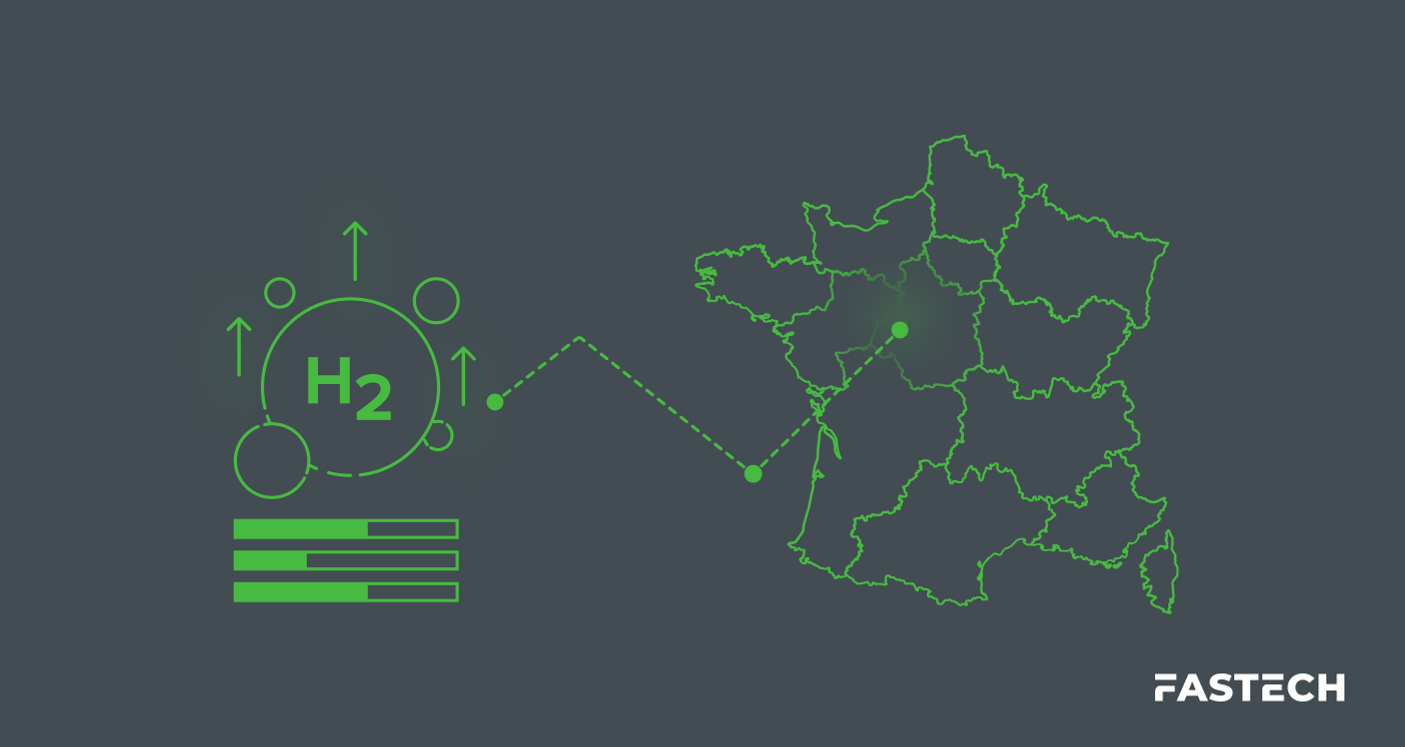The Properties of Hydrogen: Features & Energy Applications

In a time when sustainability is top of mind, hydrogen could be the solution the world has been searching for. To understand why, you must first understand the properties of hydrogen.
Hydrogen (Symbol: H, Atomic Number: 1) is the most abundant element in the universe, constituting approximately 73% of its elemental mass. Although it has a simple atomic structure, consisting of a single proton and electron, it’s complex and versatile enough to be at the forefront of modern energy research.
Below, we’ll discuss the hydrogen properties that give this element the potential to contribute to effective and sustainable clean energy infrastructure.
What Is Hydrogen?
In its base form, hydrogen (H) is a colorless, odorless, tasteless, and flammable gas. As mentioned, its atomic structure consists of a proton and an electron. This most commonly forms a diatomic molecule, H2, under ordinary conditions.
Although it only makes up a small percentage of the earth’s crust by weight (.14%), vast quantities of hydrogen can be found in various forms on our planet, including:
- As water – Found in oceans, ice packs, rivers, lakes, and the atmosphere.
- As carbon compounds – Present in all animal and vegetable tissue and petroleum.
- As hydrides – Found in combinations with metals and non-metals, which includes a wide variety of chemical structures ranging from simple metal hydrides to complex organic compounds.
Physical and Chemical Hydrogen Properties That Make it a Promising Energy Solution
While there are myriad reasons why hydrogen has emerged as the most promising candidate for sustainable energy infrastructure, three advantages, in particular, stand out. Let’s explore them.
#1 – Lightest Element with High Energy Content
Despite being the lightest element in the periodic table, hydrogen carries an astonishing amount of energy per unit. On a mass basis, hydrogen has nearly three times the energy content of gasoline: 120 MJ/kg for hydrogen versus 44 MJ/kg for gasoline.
That said, it should be noted that the situation flips on a volume basis: Liquid hydrogen has a density of 8 MJ/L, whereas gasoline has a density of 32 MJ/L.
This stark difference in energy density by volume has presented a challenge for early-stage hydrogen storage and transportation solutions. However, researchers believe they’ll be able to fully harness hydrogen’s low-weight, high-energy content in the coming decades with innovative solutions like:
- Compressed gas storage
- Advanced pressure vessels
- Materials-based hydrogen storage technologies
#2 – Clean and Non-Polluting Properties
If the dream of net zero is ever to be achieved, hydrogen must play a central role. But hydrogen's potential as a clean energy source depends on how it is produced, which isn’t always devoid of emissions.
Hydrogen gas can be produced from methane, gasoline, biomass, coal, or water. Naturally, this can have an impact on its sustainability. To provide clear distinctions between various hydrogen sources (based on the emissions produced during development and combustion), scientists introduced the color grading system.
For instance, brown hydrogen is produced by coal gasification, which results in carbon emissions. However, in the last decade, green and blue hydrogen solutions have emerged, unlocking new paths to clean energy.
- Green hydrogen – This type of hydrogen is produced using renewable energy sources, such as wind or solar power, to split water into hydrogen and oxygen. This process, known as electrolysis, results in zero emissions.
- Blue hydrogen – Blue hydrogen is derived from natural gas but utilizes carbon capture technologies to significantly reduce or even eliminate associated carbon emissions.
Either form of hydrogen represents a promising step forward in the field of clean energy, providing a fuel that, when combusted, produces only water vapor as a byproduct.
By incorporating hydrogen into our energy blend, we can significantly cut harmful emissions, edge closer to global climate goals, and foster a healthier planet.
#3 – Versatile Energy Carrier
Beyond its inherent advantageous properties, hydrogen is also adaptable as an energy carrier. Whether in hydrogen fuel cells used in automobiles and buses or in conjunction with existing energy infrastructure like natural gas pipelines, its compatibility is wide-ranging and ever-increasing.
Hydrogen offers versatility in production, as it can be generated from diverse sources. This production can be centralized, where hydrogen is created in a primary location and then distributed to various places. Alternatively, it can be produced on-site, right where it will be utilized, allowing for tailored and localized energy solutions.
The burgeoning field of hydrogen-based electricity generation offers a glimpse into a world where conventional energy barriers are overcome, integrating renewable sources with remarkable efficiency. Existing applications include:
- Transportation – Utilized in fuel cells, hydrogen powers automobiles and heavy-duty mobility vehicles, offering an alternative to conventional fuels with rapid refueling and zero emissions.
- Electricity generation – Hydrogen's use in fuel cells integrates seamlessly with existing power grids, providing on-demand electricity and supporting renewable energy sources like wind and solar.
- Industrial applications – Serving as both feedstock and fuel, hydrogen is vital in producing fertilizers and reducing metals from ores.
- Heating solutions – Its compatibility with natural gas systems enables hydrogen to be mixed into existing pipelines, providing heating and hot water to residential and commercial buildings.
- Renewable energy storage – The ability to convert and store surplus wind and solar energy positions hydrogen as a dynamic energy carrier, ensuring energy resilience via continuous energy supply even during low-generation periods.
Challenges for the Hydrogen Future
Although hydrogen carries immense promise for the future, this still-developing technology faces considerable hurdles on the road to becoming a mainstream energy solution. Potential roadblocks to widespread adoption include:
- Production – Historically, hydrogen’s production methods relied on energy-intensive processes and fossil fuels, which undercut its credentials as a truly clean fuel source. However, the rise of blue and green hydrogen could offer an attractive path forward.
- Distribution – To distribute hydrogen like we do fuel, we’ll require a robust network of pipelines, storage facilities, specialized transport systems, and refueling stations. While more of this infrastructure is being added to the grid, there’s still a long way to go.
- High cost of production and storage – Hydrogen production carries a significant cost burden and creates storage challenges, especially within the transportation sector. Innovations in production methods and storage technologies will be crucial for overcoming these economic barriers.
- Competition with other alternative fuel sources – Hydrogen must compete with other alternatives to fossil fuels, such as biofuels and electric power.
Hydrogen Technology: Powering Clean Infrastructure
Hydrogen, especially green and blue hydrogen, carries immense potential as a clean and versatile energy product. And the general public favors it. Although significant challenges remain in terms of production, distribution, competition, and so on, innovations in the field are rapidly advancing. This could position hydrogen at the forefront of sustainable energy solutions.
At FASTECH, we believe in the power of hydrogen. As a leading end-to-end energy solutions provider specializing in hydrogen infrastructure design and construction, we’re building the foundation for a zero-emission future.
To discover more about what we do, contact us today.




